One of the highlights of walking the Thames Path is the anticipation of encountering the next bridge. There are about 150 bridges along the river varying from small wooden crossings on the Upper Thames, to large structures like Tower Bridge.
All bridges may be categorised by their structure as follows:
A beam bridge is the simplest – a straightforward horizontal structure straddling the river in a single span.
A cantilever bridge is usually made up of two structures that project horizontally into space and meeting in the middle. The cantilever must be firmly anchored to hold in position.
Arch bridges distribute the weight of the bridge onto abutments on either side.
Suspension bridges use cables to hold up the bridge.
With all these structures, if the river is too wide, then “piers” in the river can be built to support multiple spans.
Here’s a rundown of some of the bridges along the Thames as you progress downstream:
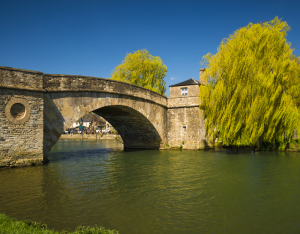
The first substantial bridge across the Thames when walking downstream from the source. Lechlade marks the start of the navigable Thames. It's name derives from its toll fee when it first opened in 1792.
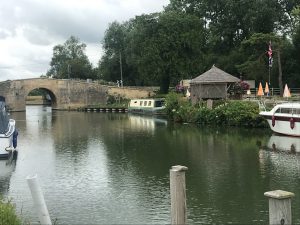
Radcot Bridge is believed to be the oldest surviving bridge on the Thames having been built around 1200 and is largely still intact.
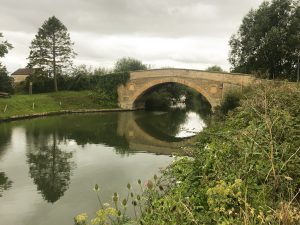
This beautiful single-span arch bridge was built in the late 18th century. The famous Trout at Tadpole Bridge overlooks the river here.
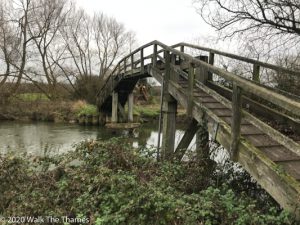
This simple footbridge crosses the river at its most remotest: near the Chimney Nature Reserve. A beam bridge?
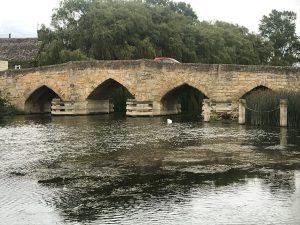
The second oldest bridge on the Thames - presumably called Newbridge as it waas built after Radcot Bridge. The Battle of Newbridge was fought here in 1644 as part of the English Civil War.
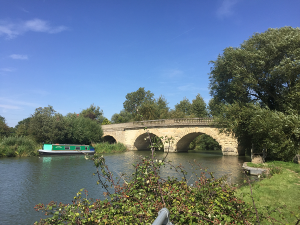
One of only two toll bridges on the Thames (aside from the Dartford Crossing which is beyond the end of the Path). The fare for a car is the mighty sum of 5p. The bridge is governed by its own Act of Parliament. Another arch bridge, opened in 1769!
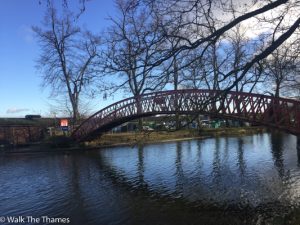
Also known as the Rainbow Bridge, this takes you from Fiddler's Island to the right bank onto Port Meadow on the left bank.It was built in 1865
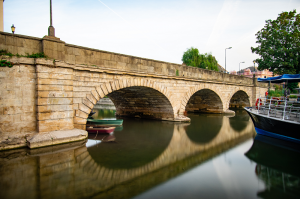
A stone arch bridge completed in 1827. Like many bridges it is in two parts, separated by an island on which the toll booth originally stood. It is built on the site where Ox were driven through a ford hence the origin of Oxford.
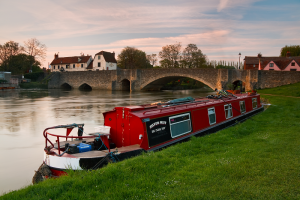
Abingdon is the next sizeable town after Oxford. Like Folly Bridge before, it uses an island, Nags Head Island, to span the river.It was completed in 1422 and so one of the oldest bridges on the Thames.
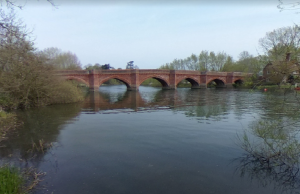
This rather elegant arch bridge was designed by Sir George Gilbert Scott and opened in 1867.He also designed Reading Gaol. It was built by local man Henry Gibbs who held the rights to the ferry. It is the first bridge we have found so far to be built in brick, the bricks supplied by Gibb's own kiln.
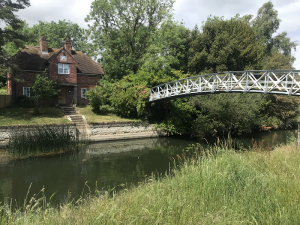
This simple scene, with the lock house in the background, epitomises the Thames. The footbridge leads to the village of Little Wittenham from where Wittenham Clumps can be climbed.
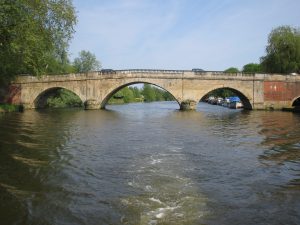
This stone bridge was built in 1827 although it replaced earlier bridges. Like many bridges it's narrow and therefore access is controlled by traffic lights.The bridge is Grade II listed.
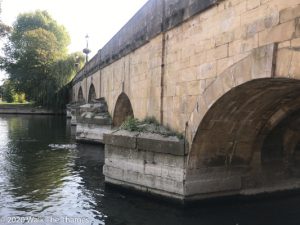
The origins of this bridge date back to the 13th century when the first stone bridge was constructed. During the English Civil War in 1646 four arches were removed and replaced with a drawbridge to help the defence of Wallingford Castle. Three arches were rebuilt in 1812. There are currently 19 arches giving the bridge a length of 900 feet.

Known as "Four Arches" this is a pair of parallel bridges carrying the Great Western Railway from London Paddington to Bristol and Wales. It is grade II listed and was originally built by Isambard Kingdom Brunel in 1839 to carry a pair of tracks. When it was decided that two more tracks be added, a second bridge was built in 1892 parallel to the first.
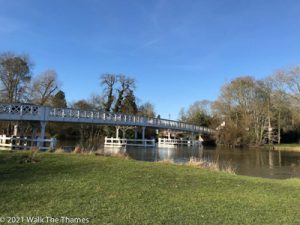
One of the newest bridges on the Thames, the present steel structure was completed in 2014. It replaced a similar structure which had been in place since 1902, although there has been a bridge here since 1792. Like Swinford Bridge, it is privately owned. Unlike Swinford Bridge, the toll fee is a little steep being 60p - although passengers and cyclists are free.
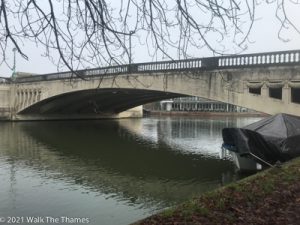
This concrete and granite bridge completed in 1926 is the fourth bridge to cross the Thames here. The first version was completed in 1231 under the direction of Henry III; a was replaced by a wooden drawbridge which was painted by Turner; this was replaced by a lattice iron construction.
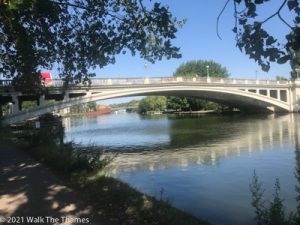
Reading Bridge was built in 1923 and therefore slightly older than its neighbour Caversham Bridge. There have been many plans drawn up for a third bridge to alleviate congestion between South Oxfordshire and Reading Borough. None have passed mostly due to objections from the residents of Caversham.
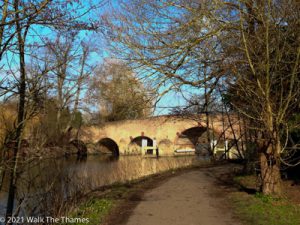
This is an arch bridge constructed from brick. Completed in 1775 it is grade II listed. Once again, the bridge uses an island to reduce its length. The island is home to Sonning Mill, a dinner and theatre venue, as well as the home of George and Amal Clooney. The village of Sonning is on the right bank, in Berkshire, with Sonning Eye being on the opposite side in Oxfordshire.
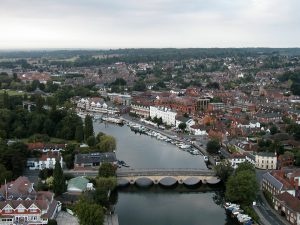
This birds-eye view of the bridge at Henley, looking upstream, shows the five stone arches built in 1786. There have been bridges here since at least 1232. It is the only bridge between Marlow and Sonning, a distance of 14 miles. It is therefore not surprising that the bridge suffers from heavy traffic. The building in the bottom left-hand corner is the Leander Club.
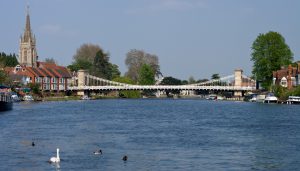
Our first suspension bridge! This magnificent structure was opened in 1832 replacing a succession of bridges dating back to the 14th century. It was closed in 2016 for three months after a 37 tonne lorry became stuck trying to cross. The weight limit is just 3 tonnes!
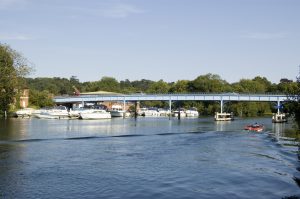
The first bridge at Cookham was built in 1840 and was made from wood. It was soon replaced by an iron bridge, the girders sitting on iron pillars filled with concrete. The toll rights were abolished in 1947. Like many bridges it is too narrow for two lanes; access is controlled by traffic lights.
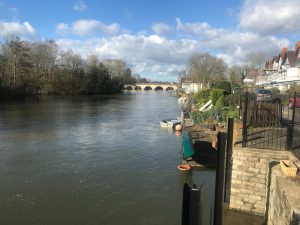
This bridge was constructed in 1775 by John Townsend who also built Swinford Bridge. It has seven arches and is made of stone. It replaced a succession of bridges starting with a wooden one in 1280. It carries the Great West Road, now the A4 and is therefore a quite substantial structure and able to carry two lanes of traffic.
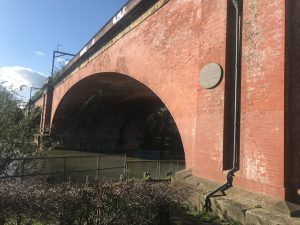
Just downstream from the road bridge is another of Brunel's structures. Commissioned in 1839 and made of two wide brick arches, it was considered innovative at the time as the arches are very low. The bridge, of course, carried the Great West Railway. The bridge is also known as The Sounding Arch.
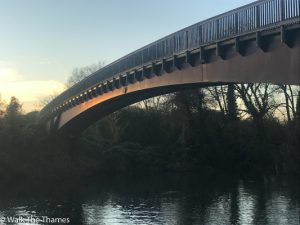
This bridge connects Monkey Island with Dorney. It's a lovely bridge to cross as it affords wonderful views. It was opened in 1996 and was originally a gravel conveyor belt removing gravel during the construction of Dorney Lake. The bridge is constructed from steel although the sidings are entirely of wood and therefore it has the feel of a rickety wooden footbridge.

Well, it is a bridge after all! But the reason for its inclusion in the list are the fabulous murals. It's also a convenient place to shelter in the rain!
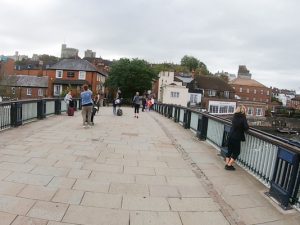
This pedestrianised bridge connects Eton with Windsor. It was opened in 1824 and is made from three cast iron arches sitting on two granite piers. It replaced a wooden bridge which had served, in various forms, since 1172. Crossing this bridge from Eton with Windsor Castle ahead is one of the highlights of the Thames Path.
Albert Bridge links Datchet with Old Windsor, carrying the B3021. It is a brick built twin-arch bridge which was opened in 1927 replacing a cast-iron bridge from 1850. During Queen Victoria's reign, the grounds of the castle expanded and the road from Old Windsor was diverted through Datchet necessitating two bridges: Albert Bridge and the nearby Victoria Bridge.
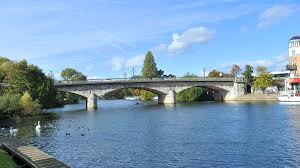
Despite its modern appearance, Staines has been an important crossing point since Roman times as it lay on the road from London to Silchester, south of Reading. The present bridge was opened in 1832
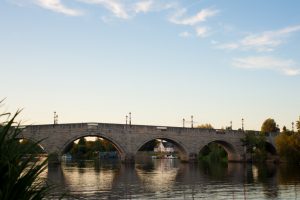
Chertsey Bridge is one of the most beautiful bridges on the Thames. Built of stone and comprising seven arches, it was built completed in 1785 by James Paine. Thames Path walkers will be disappointed to find that, on reaching the bridge, the town of Chertsey is still a further mile away.
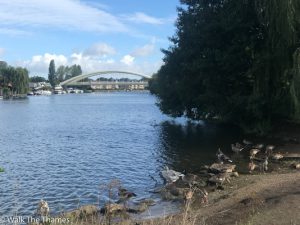
This bridge is one of the youngest on the Thames having been built in 2013. It is the sixth in a long succession of bridges, the first having been completed in 1750 and painted by Canaletto. The new bridge is a single spam bridge. Let's hope this bridge stays up longer than its predecessors. It cost £32 million.
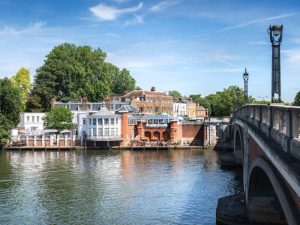
This is the fourth iteration of a bridge here and consists of three wide arches and deceptively built of re-inforced concrete. The brick and stone facings make it look older than it actually is - having opened as recently as 1933. The architect was Sir Edward Lutyens who also designed the India Gate in New Delhi. This is the fourth bridge, the first having been a wooden bridge constructed in 1753.
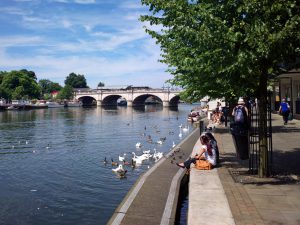
Kingston (or Kings Town) was the coronation site for Saxon kings and, for a very long time, it was the only bridge between London and Staines, the first bridge being constructed in the 12th century. The present bridge was opened in 1828 and is built of Portland stone using five arches. The bridge was widened in 1914 and is Grade II listed.

Technically there are two footbridges here, using an island to bridge across. They were completed in 1889 eplacing a ferry service. The western bridge on the left bank (see photo) is a suspension bridge. The eastern bridge is an iron girder bridge. The bridge can become very busy. The Thames Path splits here giving the walker the option of a left and right bank alternative, reuniting at Greenwich.
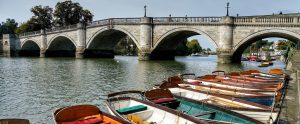
This stone arch bridge was completed in 1777. It's design was highly applauded and there are paintings of it by Turner and Constable. It was taken into public ownership in 1931 when it became toll-free. Today it is still, undoubtedly, one of the nicest bridges on the river.
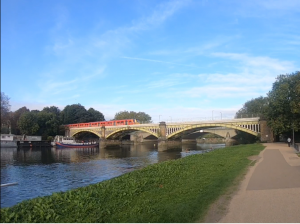
Shortly after Richmond Bridge are two bridges close to each other: a railway bridge and a busy road bridge. Neither is convenient for walkers. The railway bridge was opened in 1848 and consists of iron girders sitting on stone-facing archers.Twickenham Bridge, opened in 1933, comprises 3 concrete arches.
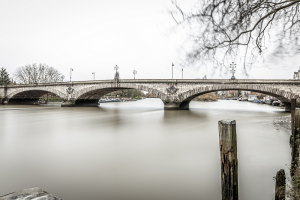
Despite its appearance, this bridge is relatively young, being completed in 1903. Linking Kew with Brentford, it is the third bridge here, the first having been opened in 1759. Before the river was dredged, Brentford was the first point on the Thames that could be crossed on foot - presumably at low tide. Some believe that Julius Caesar crossed here in 54BC.

Very much following the same design as Richmond and Kew, this arch bridge was opened in 1933 and was designed by Sir Herbert Baker who also designed the Union Buildings in Pretoria. It is built with Portland stone. The site was a former ferry. Chiswick Bridge is close to the end of the University Boat Race.
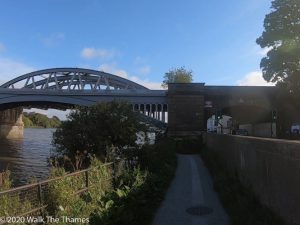
Unusually, this is a railway bridge with pedestrian access. The bridge was built in the 1890's and comprised three spans of wrought iron bow string girders. The bridge replaced an earlier and narrower construction from 1849. Pedestrian access was added with this second bridge. The bridge is Grade II listed.
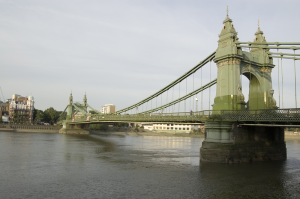
A suspension bridge without arches. It's been a while since we last saw one. This was opened in 1887. There have been 3 attempts by terrorist groups to blow it up: 1939, 1996 and 2000. It has suffered from structural problems for years - unable to support the weight of traffic going across. It is currently closed to all traffic and pedestrians.
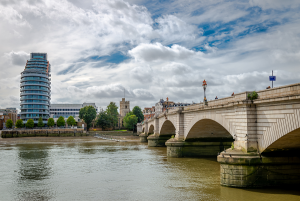
Aside from being yet another delightful bridge, this marks the start of the University Boat Race, ending near Chiswick Bridge. The bridge was originally built in 1729 on orders from Robert Walpole. It was replaced in 1886. It is unusual in that there are churches at both ends of the bridge: St Mary's Putney and All Saints, Fulham.

Just downstream of Putney Bridge, this is a railway bridge that is kind to walkers. This is a simple beam bridge built with lattice girders that sit on presumably concrete piers. The bridge was opened in 1889 and serves the Underground District Line between East Putney and Putney Bridge stations. The photo is looking downstream from the right bank.
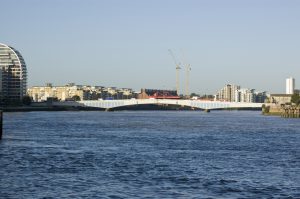
This unmistakable bridge has a distinctive colour. It opened in 1940 and was painted blue as camouflage against air raids. The colour has never changed. It's a cantilever bridge sitting on 3 spans and made from steel.Despite its colours, it has been described as "probably the least noteworthy bridge in London".
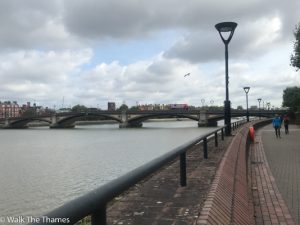
Linking Battersea with Chelsea, and only a short distance from Albert Bridge, Battersea Bridge opened in 1890. It replaced a bridge that opened in 1771 with 19 narrow spans. The bridge was rammed on many occasions requiring it to be lit - the first London bridge with this accolade. Readers may recall the news of a bottlenose whale becoming stranded at Battersea Bridge in 2006.
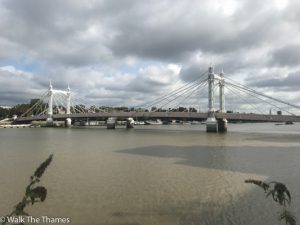
You can probably work out the approximate age of this bridge from its name. Opened in 1873 it has struggled to cope with the volume of traffic and is knicknamed "The Trembling Lady". Despite this, aside from Tower Bridge, it is the only London bridge never to have been replaced. The bridge is painted bright and illuminated at night for safety reasons.
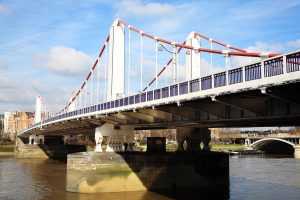
Chelsea Bridge is the one next to Battersea Power Station, which is in Nine Elms, not Battersea! So you can be forgiven if you get the bridges muxed ip! Adding to the confusion is that Chelsea Bridge looks remarkably similar to neighbouring Albert Bridge, both being suspension bridges. Built in 1937, it replaced an earlier verison which opened in 1858.
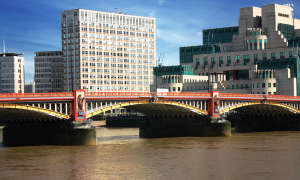
A Grade II listed steel arch bridge dating back to 1906, it replaced the Regent Bridge which opened in 1816. The design had to be changed to steel when it was found that the clay river bed would not support the original concrete design In the photo you will see MI5's headquarters.
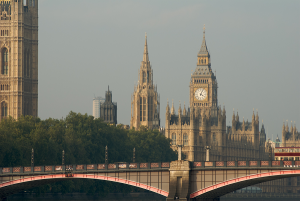
Lambeth Bridge bears a distinctive red colour intended to represent the House of Lords. Opened in 1932, this is the second bridge, the first having opened in 1862. It is a five-span steel arch bridge.The site replaces a horse ferry (a boat pulled by horses on a treadmill) which carried passengers from Lambeth Palace to Westminster Palace.

One of the great London bridges, primarily on account of its location. The original bridge opened in 1750. It was the only bridge between London Bridge and Kingston. It was replaced in 1862 by the current structure which is made from cast iron. In contrast to Lambeth Bridge, it is painted green to represent the House of Commons. It was the scene of a devastating terrorist attack in 2017 when five people died.
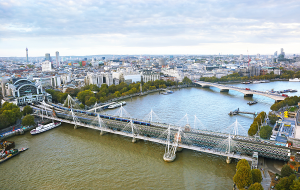
This bridge opened in 1864 and is made of 9 spans of iron girders. It replaced a suspension bridge originally designed by Brunel. Its name derives from a food market where Charing Cross station now stands. Two new footbridges were added on either side in 2002 and aptly named the Golden Jubilee Bridges.
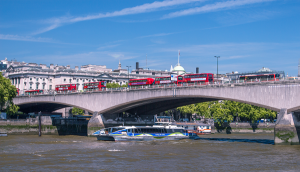
Opened in 1942, this bridge was designed by Sir Giles Gilbert Scott (Battersea Power Station). Although appearing as an arch bridge, the structure consists of reinforced concrete beams that sit on the piers.
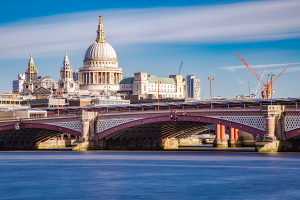
The first Blackfriars Bridge opened in 1769. Its name derives form a Dominican priory which once stood nearby. Due to various faults, a second bridge opened 100 years later and is made from five wrought iron arches. In 1982, Roberto Calvi, "God's Banker" was found hanging from one of the arches. It is believed he was murdered by the mafia.
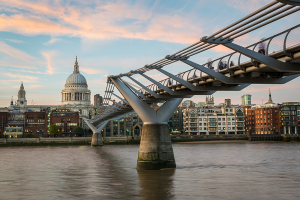
One of London's newest bridges, this footbridge opened, obviously, in 2000 at a cost of £18.2 million. It is a steel suspension bridge with a propensity to sway, hence its nickname "the Wobbly Bridge". After it was opened it closed for nearly 2 years whilst it underwent some adjustments. It links St Paul's Cathedral with Bankside (the Gobe and Tate Modern).
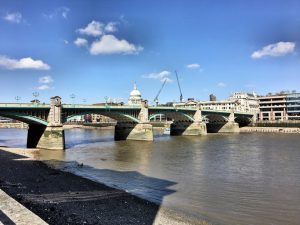
A relatively modern bridge, this opened in 1921. It's an arch bridge. It replaced an earlier bridge which opened in 1819 and had the longest iron span ever made. It was known as the Iron Bridge. Pedestrians can access a tunnel underneath the tunnel on the right bank where there is a collection of friezes depicting the Thames Frost Fairs.
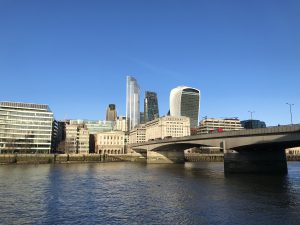
Bridges have been here since Roman days when a succession of wooden bridges were built. In the 12th century work started on a stone bridge. Buildings stood on top to provide income to the bridge company. Until 1750 this was the only bridge in London. It was replaced in 1831 by a bridge with 5 stone arches. Unfortunately it was sinking and had to be replaced. The current structure. which consists of 3 concrete box girders, opened in 1973.
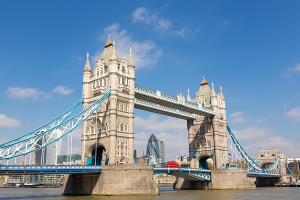
Probably the most famous bridge in the world, this bridge is just a baby having opened in 1894. The towers are made of steel but faced with stone to create a Gothic look. The approaches to the towers are suspended. The drawbridge, which allows ships into the Pool of London, opens using bascules housed in the base of the tower.
Tower Bridge is the last bridge whilst walking the Thames Path. That’s no surprise as London is, historically, a port. Ships and bridges sometimes clash. The main port of London originally stretched from London Bridge to Rotherhithe: the Pool of London. As the Pool became increasingly busier, new docks were opened further downstream in what we now know as the Docklands at the turn of the 19th century. The Pool began to decline in importance and, by the time Tower Bridge was built in 1894, there were fewer ships coming as far upstream.
The invention of the container ship marked the end of both the Pool and the Docklands. The port of London again moved downstream: to Tilbury and then to the London Gateway, both beyond the Queen Elizabeth II bridge which carries the M25.
Ready to book?
| Cookie | Duration | Description |
|---|---|---|
| cookielawinfo-checkbox-analytics | 11 months | This cookie is set by GDPR Cookie Consent plugin. The cookie is used to store the user consent for the cookies in the category "Analytics". |
| cookielawinfo-checkbox-functional | 11 months | The cookie is set by GDPR cookie consent to record the user consent for the cookies in the category "Functional". |
| cookielawinfo-checkbox-necessary | 11 months | This cookie is set by GDPR Cookie Consent plugin. The cookies is used to store the user consent for the cookies in the category "Necessary". |
| cookielawinfo-checkbox-others | 11 months | This cookie is set by GDPR Cookie Consent plugin. The cookie is used to store the user consent for the cookies in the category "Other. |
| cookielawinfo-checkbox-performance | 11 months | This cookie is set by GDPR Cookie Consent plugin. The cookie is used to store the user consent for the cookies in the category "Performance". |
| viewed_cookie_policy | 11 months | The cookie is set by the GDPR Cookie Consent plugin and is used to store whether or not user has consented to the use of cookies. It does not store any personal data. |